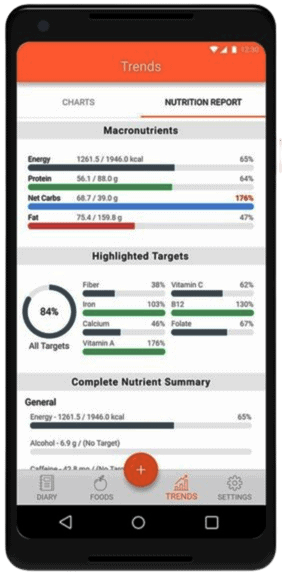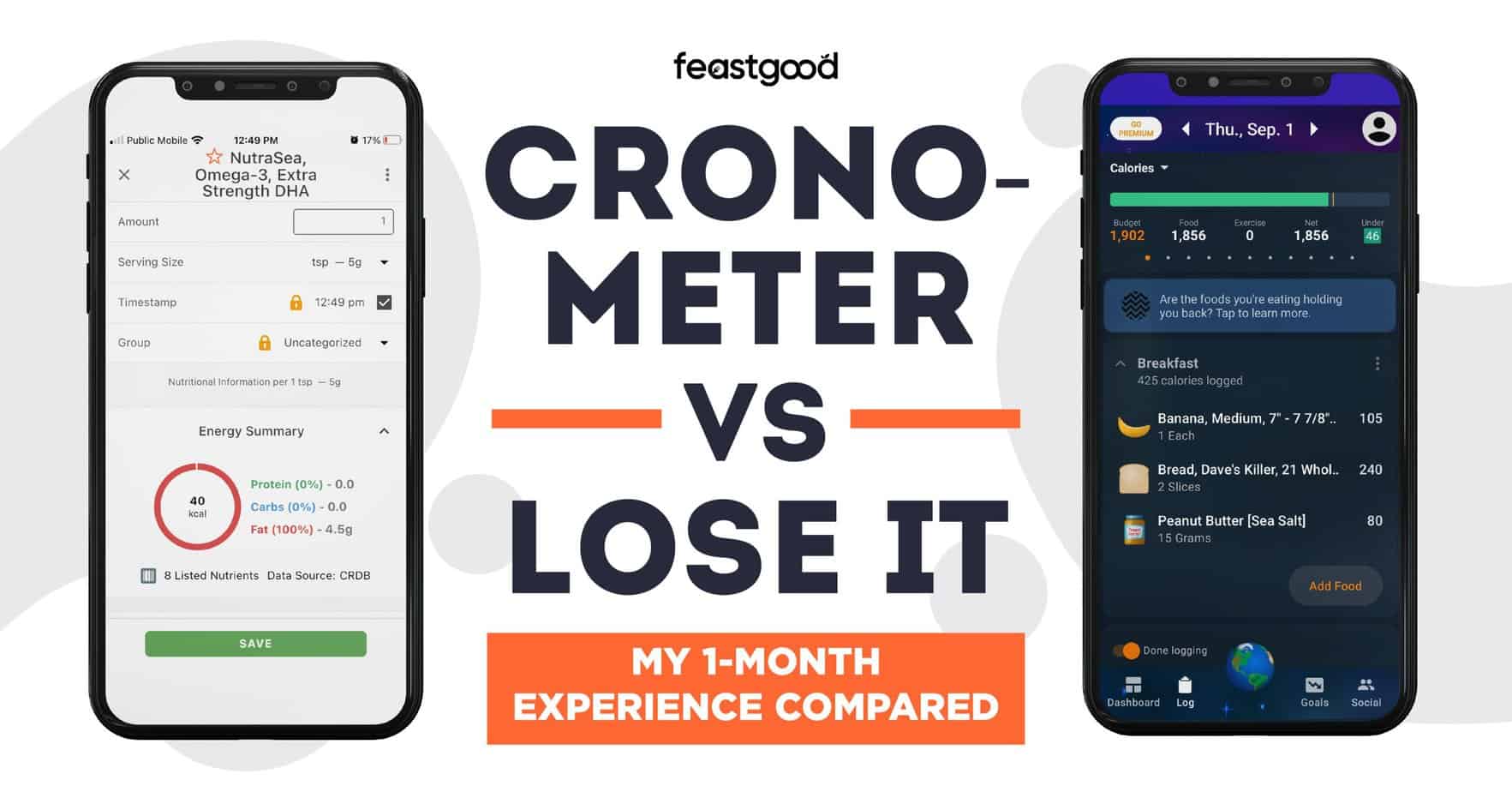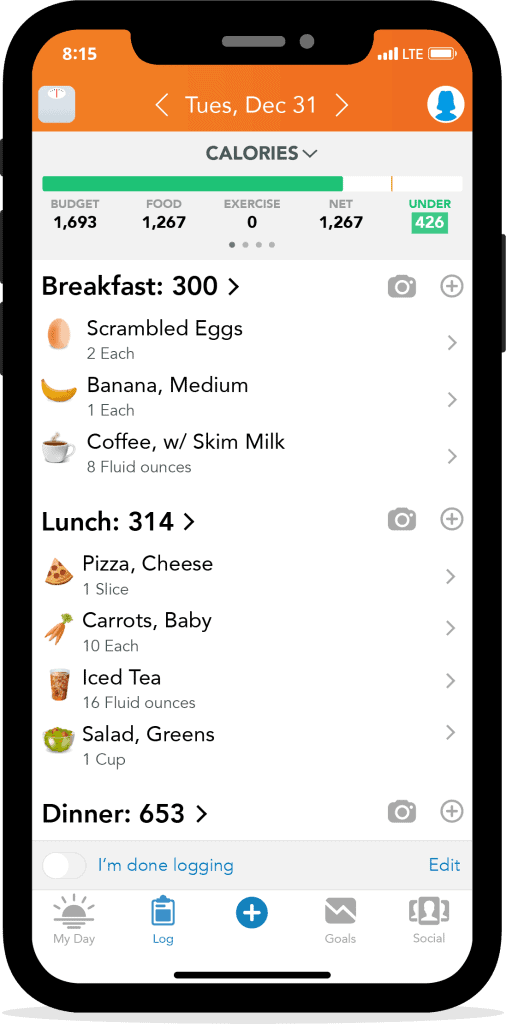Our team at FeastGood.com has put together 20+ reviews on diet-tracking apps, including both Cronometer and Lose It, so we’re in a perfect position to let you know the pros and cons of each app and how they stack up side by side.
Key Takeaways
- The main difference between Cronometer and Lose It is that Cronometer is focused on macronutrient, micronutrient, and biometric tracking, whereas Lose It focuses on tracking calories only.
- Cronometer won 8 of 10 categories reviewed (more on this later), and the remaining two categories were ties. Most of the features in the Lose It premium version ($39.99/year) are available in the free version of Cronometer.
- Cronometer is best for people who want to focus on tracking macronutrients and/or micronutrients, such as athletes, people with body composition goals, or others who are managing a health condition.
- Lose It is best for people whose primary goal is weight loss, without concerns for body composition or performance, and for anyone who would be overwhelmed focusing on more than calories.

Overall Rating: 4.4/5
Cronometer

Overview
Features
Best For
*This link gets you 10% off the gold plan. No code is required.

Overall Rating: 4.0/5
Medical Disclaimer: The content of this article is provided for educational insights only. It should not be used as medical guidance. Individuals with a past of disordered eating should refrain from weight loss programs or calorie tracking. For medical advice, consult a certified healthcare professional. If you’re struggling with eating disorders, contact NEDA for assistance.

What Is Cronometer?
Cronometer is more than just a nutrition app because it allows you to track lab results such as blood tests or blood pressure, and biomarkers like body fat, measurements, sleep and mood, on top of calories, macronutrients, micronutrients, and water intake. You can really optimize your health and not just your weight.
Cronometer allows you to set custom targets for your daily intake of calories, macronutrients, and micronutrients.
This way, your goals can be for losing, gaining, or maintaining weight, or for improving a health condition like blood pressure or cholesterol levels.
Cronometer’s detailed reports can be easily exported to share with your health care providers, or you can make your own custom reports for your own use, focusing on things that are important to you.
For example, I actually track my carbohydrate intake compared to my hours of sleep, to see if there is a connection between getting enough carbs and sleeping well.
Read my complete Cronometer Review here.
Pros
- Energy settings are customizable
- Database of foods is verified
- Micronutrient information is detailed and extensive
- Library of biomarkers is comprehensive, and you can add your own
- Reports can be customized
- Recipes can be shared, and they include Notes for instructions
- Community support is excellent on several different platforms
Cons
- Calorie counts don’t display in search results until you click on the entry
- No grouping of foods into meals/snacks in the free version; all foods appear in one big list
What Is Lose It?
Lose It is a nutrition app focused on weight loss, just as the name suggests. It provides users with a calorie target for weight loss, and the premium version provides the option to track macronutrients (protein, carbs, and fat) and a small number of micronutrients as well.
Using the basic (free) version of Lose It, the calorie recommendation for me was way too low as it did not have a way to capture my high training load.
My normal maintenance level of calories is around 2,300, and Lose It suggested a calorie intake of only 1,200, which is much too big of a calorie deficit for healthy, sustainable weight loss.
Also, its macronutrient suggestions are not accurate either and do not necessarily even line up with the recommended calories.
You can, however, adjust the calorie and/or macronutrient recommendations, if you know what they should be. You may need to work with a Registered Dietician or nutrition coach to determine appropriate targets for your goals though.
Lose It can send daily or weekly nutrition reports to your coach, with a summary of calories eaten and burned, including all food logs.
Users also really enjoy the “badges” they can earn when they log their foods and are on track with meeting their goals. This is a fun way to keep people motivated.
On the other hand, it’s disappointing to see that most of the features in the app are only available in the paid version, and membership options are either annual or lifetime, meaning you can’t use it for just a few months.
Read my complete Lose It App review here.
Pros
- Energy settings are customizable
- Community is built-in
- Badges and rewards are motivating and help users achieve their goals
Cons
- Macronutrient recommendations are inaccurate
- Many features are only available in the paid version
- Membership options are limited
Cronometer vs. Lose It: Head To Head Comparison
1. Food Database
Cronometer
Cronometer’s database is verified, with lab-analyzed data from the Nutrition Coordinating Center Food & Nutrient Database (NCCDB), the United States Department of Agriculture National Nutrient Database for Standard Reference (USDA), and the Elizabeth Stewart hands and Associates (ESHA) database.
It’s also possible for Cronometer users to submit food items for verification to be added to the database, by including a photo of the nutrition label for a new product. These items show up as CRDB (Cronometer User Database).
Keep in mind that CRDB verified entries only check to see if the nutrition information matches the nutrition label on the product, so it depends whether the manufacturer published an accurate label.
Food labels allow for some rounding, so choose the database entries NCCDB, USDA or ESHA for the highest accuracy.
Lose It
Lose It’s database includes both verified and unverified foods. But, the verified foods in Lose It are only verified by the Lose It team, as opposed to an independent database like the NCCDB or USDA, meaning the information may not be as accurate.
The Winner: Cronometer
Cronometer’s verified database makes it more likely that your intake will be accurate, allowing you to hit your goals. In Lose It, you could choose an unverified entry, or the verified information might still not be accurate.2. Tracking Capabilities
Cronometer
There are very few things that Cronometer does not track. If you can measure it, you can track it in Cronometer because there is an option to create custom metrics.
Any medical test you have, you can record the result in Cronometer (blood glucose, blood pressure, blood tests, etc.).
You can also record water intake and exercise in addition to logging your food (which will capture calories, macronutrients, and micronutrients).
The outputs such as your weight, body fat, and body measurements (and even your poop!) can all be measured.
Lose It
Lose It also tracks food data (calories, macronutrients and a short list of micronutrients), but beyond weight, many of the “output” variables (such as measurements or tests) are only available in the paid version.
Also Lose It reports are only available in the premium version.
The Winner: Cronometer
Cronometer’s extensive tracking options and the fact that many of the tracking options in Lose It are only in the paid version make Cronometer the winner.3. Calorie Recommendations
Keep in mind that an appropriate calorie deficit for a healthy and sustainable rate of fat loss is about 50-500 calories per day (no more than a 15-20% reduction from the number of calories needed to maintain your weight).
Cronometer
Cronometer’s calorie recommendations are very adjustable, and can even be overridden completely if you have been provided targets from a healthcare professional such as a Registered Dietician or nutrition coach.
Cronometer is able to provide you with a much more accurate recommendation to meet your stated weight goals (whether that is to lose, gain, or maintain), because there are many options to adjust both basal metabolic rate and activity level to estimate your total calories burned.
Lose It
Lose It’s calorie target recommendation was very inaccurate for me (1,100 calorie deficit), but it was very accurate for another nutrition coach on our team (400 calorie deficit), so it’s hard to know if it’s likely to be accurate for the average user.
The good news is that you can also override the target in Lose It, if you know what it should be.
The Winner: Cronometer
Cronometer allows you to see the inputs that go into estimating your total daily energy expenditure (TDEE), as well as how much of a deficit below that TDEE you want to choose (recall our advice of 50-500 calories) if your goal is to lose weight. This level of detail makes Cronometer the winner in this category.4. Level of Customization
Cronometer
Cronometer’s customization options are very extensive and don’t just apply to setting calorie targets (discussed above). You can also set macronutrient targets to the exact gram.
Then, you can also customize the dashboard and the reports to show what you want to see. Is it calories burned? Calorie balance (intake versus exercise)? Are there only certain macronutrients you want to see?
You can share your reports, graphs and charts with your healthcare provider, which can help you to see trends in intake versus different health outcomes. For example, does eating more fibre help your cholesterol levels?
Lose It
Lose It’s customization applies to calories, macronutrients and micronutrients. You can even choose whether you want to have different targets for different days of the week such as if you are carb cycling and want to have some high-carb days and some low-carb days.
Lose It also has reports, but they are less detailed, showing only calories eaten and burned, and food items, but not detailed micronutrient information like in Cronometer. Plus, these reports are only available in the premium version.
The Winner: Cronometer
Cronometer customization for reports and charts gives it the edge compared to Lose It.5. Education Opportunities
Cronometer
“Ask the Oracle” is one of my favorite features in Cronometer. It allows me to find out what foods are the best sources of a given micronutrient.
For example, I was able to see that I was often low on phosphorus intake when I looked at my detailed daily nutrition report in Cronometer (this is a standard report). I was able to find the foods that are the best sources of phosphorus using “Ask the Oracle.”
Cronometer allows you to learn about micronutrient content of foods, and which foods are the best sources of different micronutrients if you need something in particular (or if you need to avoid eating too much of a certain micronutrient, perhaps because it interferes with a medication you are taking).
Plus, as you log your food, you also learn about the calorie count and macronutrient breakdown of different foods for given serving sizes.
Lose It
Like Cronometer, Lose It gives you knowledge about calorie count and macronutrient breakdown when you track your food.
The Winner: Cronometer
Cronometer provides all of the same nutrition information as Lose It (plus it’s more likely to be accurate), and then gives you even more detailed micronutrient information and the “Ask the Oracle” feature.6. Coaching
Cronometer
Cronometer doesn’t have a built-in coaching feature, but it does have Cronometer Pro which is specifically for health professionals like coaches or dieticians to use with their clients.
In Cronometer Pro, coaches can communicate with clients directly in the app and they get a dashboard view to see their clients’ intake.
Lose It
There is no coaching feature in Lose It.
The Winner: Cronometer
The ability for coaches to work with clients in the Cronometer Pro version of the app makes it the winner for coaching.7. Recipe Database
Cronometer
There is no recipe database in Cronometer, but users can input their own recipes, or import recipes if they have a URL (a recipe from a website, like one of our recipes here at FeastGood – I shared how to make high-protein ice cream), and coaches can share recipes with their clients.
Plus, in the Gold version of Cronometer, users can share recipes with friends in the app.
Lose It
There is no recipe database in Lose It.
The Winner: Cronometer
While neither app has a dedicated recipe database, the fact that you can create, import, and share recipes in Cronometer makes it the winner.8. Exercise Calories
When you log exercise in a nutrition app (or sync it from a connected device like an Apple Watch), most apps will estimate how many calories you burned while doing that exercise.
Some apps will automatically add these estimated calories to your daily total.
But, you may not want that: your daily total might already include an amount for activity, or you might want to keep a lower daily target so that your exercise creates a calorie deficit for weight loss.
I’ll cover what each app does with exercise calories:
Cronometer
Cronometer has two settings related to exercise calories:
- Users can import “activity calories” from activity trackers like FitBits, Garmins or Apple Watches and can use these activity calories instead of a calculated “activity multiplier” that is used in estimating total calories burned for the day (TDEE: total daily energy expenditure).
- Users can also decide whether exercise calories should be added to their total daily calorie target, or ignored.
Lose It
Lose It will either add all of the calories you burned from activity on top of your daily calorie total OR you can choose “exclude from total calories” when you log your activity.
The Winner: Tie
Since you can choose whether or not to include activity calories in either app, I’m declaring this a tie.9. Price
Cronometer
Cronometer has all of the features I’ve been describing in the free version.
The only things that are not included are recipe sharing and the ability to log foods in separate meals. These two features exist only in Cronometer Gold.
A Cronometer Gold membership is $49.99/year (<$5 per month).
Lose It
Many of the more detailed (and most helpful) features in Lose It are only available in the paid version, such as the ability to easily see and set macronutrient targets, or to log body measurements.
It’s quite unusual that Lose It has only 2 membership options (annual or lifetime) since most apps have a monthly option in case you only want to try it for a month or if your goal only takes 6 months to achieve.
On the other hand, a lifetime membership is less expensive in the long-run if you use the app for several years.
A Lose It membership is $39.99/year, or $189.99/lifetime.
The Winner: Tie
Cronometer’s free version has more functionality that Lose It’s free version, but Cronometer Gold costs $10 more per year than Lose It premium and there is no lifetime option for Cronometer.10. Reviews
Cronometer
In the Apple App store, Cronometer has 4.7 / 5 stars from over 41 thousand reviews. People love all the details they are able to track, and the ability to really focus on health and good nutrition and not just weight loss (or gain).
Lose It
In the Apple App store, Lose It has 4.5 / 5 stars from over 571 thousand reviews. Users were successful in losing weight while using the app (although they might have had the same success regardless of what app they used).
The Winner: Cronometer
Cronometer has a better rating than Lose It (but Lose It has many more reviews than Cronometer so it might not be a fair comparison).Cronometer vs. Lose It: Quick Overview
| App | Cronometer | Lose It | Our Interpretation |
|---|---|---|---|
| Food Categorization | None - Cronometer doesn’t rank or rate foods | None - Lose It doesn’t rank or rate foods | Both are macro and/or calorie tracking apps that don’t qualify foods as “good” or “bad”. |
| Tracking Capabilities |
|
| Cronometer has much more detailed and comprehensive tracking for macronutrients, micronutrients, and biometrics. Lose It only offers basic tracking, with most details only available in the premium version. |
| Calorie Recommendations & Accuracy | Calorie recommendations are accurate and advanced users can make their own customizations.. | Calorie starting recommendations for weight loss are too low for active individuals and/or those with high muscle mass, but they can be customized. | Cronometer’s recommendations are more accurate because they allow for more custom inputs & details. |
| Level of Customization | Ability to customize calorie, macronutrient and selected micronutrient targets. Can also generate custom reports to compare variables of your choosing. | Ability to customize calorie, macronutrients and micronutrient goals. | Both Lose It and Cronometer have opportunities for customization, but more are available in the free version of Cronometer, and Cronometer also has custom reports. |
| Education Opportunities | “Ask the Oracle” shows which foods are best for providing a given micronutrient. Plus, you’ll learn about nutritional info when logging food. | You’ll learn about nutritional info when logging food, but there are no formal education tools in Lose It. | Cronometer allows users to learn about recommended intake of micronutrients and macronutrients. Lose It data gives users information about serving sizes, calories, and macronutrients. |
| Coaching | None | None | Cronometer & Lose It are self-directed apps, but Cronometer has a coaching dashboard for nutrition coaches. |
| Recipe Database & Meal Planning | There is no recipe database and no meal planning functionality. | There is no recipe database and no meal planning functionality. | Neither Cronometer or Lose It has a recipe database, but Cronometer allows you to create, import and share recipes. |
| Exercise Calories | Choice to include exercise calories or not. | Choice to include exercise calories or not. | Both apps allow users to add or ignore exercise calories. |
| Price |
|
| Lose It is unique with a one-time option for lifetime membership. |
| Reviews | 4.7/5 for 41k reviews (as of Feb 2023) | 4.5/5 for 571k ratings (as of Feb 2023) | Both apps are very popular with lots of positive comments, but Cronometer is newer and has fewer ratings. |
Other Diet App Comparisons:
- Cronometer vs MyFitnessPal
- Noom vs Lose It
- MyMacros+ vs Cronometer
- MacroFactor vs Cronometer
- Lifesum vs. Lose It
About The Author

Lauren Graham is a Precision Nutrition Level 1 certified nutrition coach. She focuses on helping busy professionals balance healthy eating and purposeful movement. Lauren has a background in competitive swimming and is currently competing as a CrossFit athlete. She has a passion for training, teaching, and writing.
Why Trust Our Content

On Staff at FeastGood.com, we have Registered Dietitians, coaches with PhDs in Human Nutrition, and internationally ranked athletes who contribute to our editorial process. This includes research, writing, editing, fact-checking, and product testing/reviews. At a bare minimum, all authors must be certified nutrition coaches by either the National Academy of Sports Medicine, International Sport Sciences Association, or Precision Nutrition. Learn more about our team here.
Have a Question?
If you have any questions or feedback about what you’ve read, you can reach out to us at [email protected]. We respond to every email within 1 business day.

